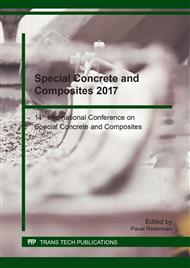p.43
p.49
p.55
p.61
p.67
p.73
p.83
p.91
p.96
Microstructure and Pore Systems Development of Ternary Gypsum-Based Mortars
Abstract:
Paper deals with ternary gypsum-based mortars with higher resistance against water, prepared from gypsum, hydrated lime, several pozzolans (crushed ceramic, silica fume, granulated blast slag) and sand. The samples were stored in the water and the pore systems development in time was studied by mercury intrusion porosimetry. The change of pore structure in samples with pozzolans were observed, the size of pores shifted to the smaller pores during tested period. The elementary composition and microstructure of all materials were also studied by scanning electron microscopy (SEM).
Info:
Periodical:
Pages:
67-72
Citation:
Online since:
January 2018
Keywords:
Price:
Сopyright:
© 2018 Trans Tech Publications Ltd. All Rights Reserved
Share:
Citation:


